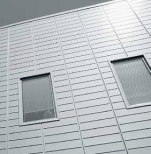Aeroelasticity Estimation in the Construction of Curtain Wall Systems

Aeroelasticity or aeroelastic interaction happens when an elastic object interacts with the air (air flow). During this process the air flow affects the objects and vice versa the object affects the air flow: aerodynamic forces that act on the elastic object trigger the deformation of its surface, which in its turn changes the aerodynamic forces. In our case the elastic object is either a building or a structure.
As an independent branch aeroelasticity appeared in the 30’s of the previous century and it was closely connected with the developing aviation. M. Keldysh’s projects of the late 30’s laid the mathematical basis for the theory of aeroelasticity and made it possible to simulate the phenomenon in aerodynamic tunnels. The following researches contributed a lot to the study of practical issues of aeroelastic interactions: E. P. Grossman, Y. M. Parkhomovskiy, L. S. Popov, etc. N. M. Bronstein was the first to implement dynamic calculations in the field of engineering structures. Dynamic interactions of buildings and structures were also studied by S. P. Timoshenko, I. M. Rabinovich, B. G. Korenev, etc. We can name V. Bierbaum, T. Carman, E. Simiu, A. Fershing, R. Mase among the foreign scientists who developed analytical, numerical and experimental methods of aerodynamics.
When the wind flows around the building there occurs the socalled instability of the aerodynamic parameters of the environment; a dramatic change of pressure takes place when the flow gets away from the construction. Vortex formation is triggered. As a result the appearing aerodynamic forces lead to the additional load of the building itself as well as its certain parts; and it is essential that this secondary stress is considered when strength prediction of CWS is estimated. Most aeroelastic processes are of self-vibrating nature; it is caused by the energy exchange between the flow and the body in stream.
The main aeroelastic phenomena are flutter (stalling flutter) and buffeting. When considering aeroelasticity in terms of its impact on the structure, it is necessary to mention such things vortex excitation, galloping across the air flow, divergence and half-integral resonance. From the point of view of the stability theory (founded by A. A. Lipunov) aerodynamic interactions can also be considered as processes of aeroelastic stability. Flutter is the undamped elastic vibration of the structure (or its parts) when the air flows in it at a certain (critical) velocity.
Flutter is a kind of self-induced vibrations with the energy source being the wind current and the feedback realized by the elastic building structure (or its part). At certain angles of interaction the current can stall (the so-called stalling flutter). Needless to say that stalling flutter usually occurs when the velocity of flow is low. Besides that there exists such a poorly studied phenomenon as panel flutter, i.e. undamped vibration of the panels (wainscot) that stems from the air flow that streams along them at a high velocity.
Full version you can download here
 Text : VICTOR RAZUVAEV, head of the design and constructi on company “Aluterra SK” LLC, ANTON SU TYAGIN, chief technical officer of the design and construction company “Epsilon”
Text : VICTOR RAZUVAEV, head of the design and constructi on company “Aluterra SK” LLC, ANTON SU TYAGIN, chief technical officer of the design and construction company “Epsilon”


